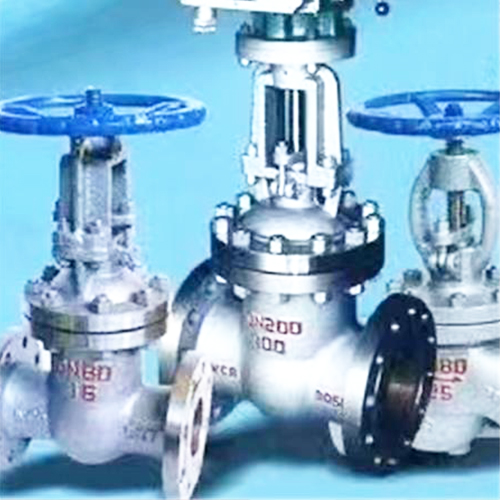那么電動閥門中開關量和模擬量有什么區別呢?
So what is the difference between switching value and analog value in electric valve?
1,開關量:該物理量只有兩種狀態,如開關的導通和斷開的狀態,繼電器的閉合和打開,電磁閥的通和斷,等等。是指非連續性信號的采集和輸出,包括遙信采集和遙控輸出。它有1和0兩種狀態
1. Switching value: the physical quantity has only two states, such as on and off of the switch, on and off of the relay, on and off of the solenoid valve, etc. It refers to the acquisition and output of discontinuous signals, including remote signal acquisition and remote control output. It has two states: 1 and 0
2,模擬量:控制系統量的大小是一個在一定范圍內變化的連續數值。比如溫度,從0~100度,壓力從0~10Mpa,液位從1~5米,電動閥門的開度從0~100%,等等,這些量都是模擬量。指變量在一定范圍連續變化的量;也就是在一定范圍(定義域)內可以取任意值(在值域內)。
2. Analog quantity: the control system quantity is a continuous value varying within a certain range. For example, the temperature is from 0 to 100 degrees, the pressure is from 0 to 10MPa, the liquid level is from 1 to 5m, the opening of electric valve is from 0 to 100%, etc. these quantities are analog quantities. It refers to the quantity that the variable changes continuously in a certain range; That is, any value (within the value range) can be taken within a certain range (definition range).

對控制系統來說,由于CPU是二進制的,數據的每位只有和兩種狀態,因此,開關量只要用CPU內部的一位即可表示,比如,用表示開,用表示關。而模擬量則根據精度,通常需要8位到16為才能表示一個模擬量。常見的模擬量是12位的,即精度為2-12,高精度約為萬分之二點五。當然,在實際的控制系統中,模擬量的精度還要受模擬/數字轉換器和儀表的精度限制,通常不可能達到這么高。
For the control system, since the CPU is binary and each data has only one and two states, the switching value can be represented by one bit inside the CPU, for example, on and off. The analog quantity usually needs 8 to 16 bits to represent an analog quantity according to the accuracy. The common analog quantity is 12 bits, that is, the accuracy is 2-12, and the high accuracy is about 2.5 per 10000. Of course, in the actual control system, the accuracy of analog quantity is also limited by the accuracy of analog / digital converter and instrument, which is usually impossible to reach such a high level.
開關量僅有兩種相反的工作狀態,例如高電平和低電平,繼電器線圈的通電和斷電,觸電的接通和斷開,PLC可以直接輸入和輸出開關量信號。有的PLC將開關量稱為數字量。
There are only two opposite working states of switching value, such as high level and low level, power on and power off of relay coil, power on and power off of electric shock. PLC can directly input and output switching value signals. Some PLCs call switching value digital value.
模擬量是連續變化的物理量,例如電壓,溫度,壓力和轉速等PLC,不能直接處理模擬量,需要用模擬量輸入模塊中的A/D轉換器,將模擬量轉換為與輸入信號成正比的數字量。PLC中的數字量(例如PID控制器的輸出)需要用模擬量輸出模塊中的D/A轉換器將它們轉換為與相應數字成比例電壓或電流,供外部執行機構(例如電動調節閥或變頻器)使用。
Analog quantity is a continuously changing physical quantity, such as voltage, temperature, pressure and speed. PLC can not directly process analog quantity. It needs to use the A / D converter in the analog input module to convert analog quantity into digital quantity proportional to the input signal. The digital quantities in PLC (such as the output of PID controller) need to be converted into voltage or current proportional to the corresponding digital by D / a converter in analog output module for use by external actuator (such as electric control valve or frequency converter).
開關量不是通電,就是斷電,或稱為0和1,0代表通電,1代表斷電。例如,按鈕,開關,時間繼電器,過電流壓力繼電器,這類屬于輸入,輸出的有接觸器,繼電器,電磁閥等。模擬量是一種連續變化的量,例如,輸入的有:傳感器,(好多種)輸出的有:伺服電動機,電磁閥,距離,速度等控制信號。換句說法說:開關量是真實物體,而模擬量是一個虛擬物體,比如在電腦上畫畫等。
The switching value is either energized or de energized, or called 0 and 1. 0 represents energized and 1 represents de energized. For example, buttons, switches, time relays, overcurrent and pressure relays belong to input and output contactors, relays, solenoid valves, etc. Analog quantity is a continuously changing quantity. For example, the input includes sensors, and the output includes servo motor, solenoid valve, distance, speed and other control signals. In other words, the switching value is a real object, while the analog value is a virtual object, such as drawing on a computer.
The wonderful content of this article is provided by Shanghai Lianggong valve Shandong Sales Office. There are many wonderful content on this website. You can click to enter more content: http://www.szgotta.com.cn We have special customer service to answer your questions
 企業公告:
企業公告:
























